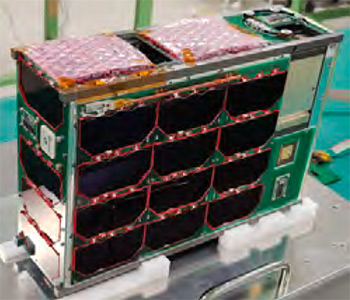Thank you very much for visiting Gunter's Space Page. I hope that this site is useful and informative for you.
If you appreciate the information provided on this site, please consider supporting my work by making a simple and secure donation via PayPal. Please help to run the website and keep everything free of charge. Thank you very much.
KITSUNE

KITSUNE [Kyutech]
KITSUNE (Kyutech standardized bus Imaging Technology System Utilizing Networking and Electron content measurements) is a technological CubeSat (6U) built by Kyushu Institute of Technology (Kyutech) jointly with the Agencia Espacial del Paraguay (AEP).
The KITSUNE mission has five objectives:
- High resolution camera mission:
The camera payload onboard KITSUNE satellite will capture 5 meter-class resolution images. KITSUNE satellite will use attitude determination and control system to aim the camera payload to capture 5 images around a target. During the next pass, by UHF uplink command, images will be downlinked over C-band communication. If C-band communication fails, UHF downlink will be used for images as well as telemetry. - C-band communication demonstration mission:
The C-band communication board on KITSUNE satellite will demonstrate up to 20 Mbps amateur high-speed data downlink. - C-band mobile ground station mission:
A C-band mobile ground station is being developed as an independent system from the main ground station. Mobile ground station will uplink a command to the small 2-megapixel camera onboard the satellite to take 2 megapixel compressed images and downlink immediately. The objective is to demonstrate downlink speed up to 1Mbps over C-band to the mobile ground station. The mobile ground station will use the same frequencies as the main ground station. - Total Electron Content Measurement Mission (mission without amateur link involvement):
KITSUNE satellite carries a chip-scale atomic clock. It will be used to detect the time delay between uplink command sent from the ground station and receiving time on the satellite side. The ground station will send dummy data over 450MHz spread-spectrum signal, and it will record the time of the signal transmission at the ground station. KITSUNE satellite will receive this signal over software defined radio (SDR) and record the receiving time by using GPS time and chip-scale atomic clock. Recorded transmission times will be sent over 450 MHz UHF communication uplink. The time difference will be used to calculate total electron content of ionosphere onboard. UHF non-amateur downlink (400.960 MHz ) will be used to downlink the scientific data and telemetry. - Store and Forward Mission (IoT Mission) (mission without amateur link involvement):
KITSUNE satellite has a LORA device onboard as a receiver. There will be fixed and mobile ground sensor terminals with LORA devices. They will collect sensor data (temperature, humidity, gps location etc.) and transmit the data over 400MHz and 433MHz ISM band non-amateur frequencies. KITSUNE satellite will collect the data from the ground sensor terminals and downlink to the main ground station over 400.960 MHz non-amateur data downlink. First ground sensor terminal will be set up in Kyushu Institute of Technology campus.
| Nation: | Japan, Paraguay |
|---|---|
| Type / Application: | Technology, education |
| Operator: | Kyushu Institute of Technology (Kyutech), AEP |
| Contractors: | Kyushu Institute of Technology (Kyutech), AEP |
| Equipment: | Cameras |
| Configuration: | CubeSat (6U) |
| Propulsion: | None |
| Power: | Solar cells, batteries |
| Lifetime: | ~ 6 months |
| Mass: | 14 kg |
| Orbit: | 414 km × 418 km, 51.64° |
| Satellite | COSPAR | Date | LS | Launch Vehicle | Remarks | |
|---|---|---|---|---|---|---|
| KITSUNE | 1998-067TK | 19.02.2022 | WI LC-0A | Antares-230+ | with Cygnus CRS-17, NACHOS 1, IHI-Sat |
References:
- IARU: KITSUNE
